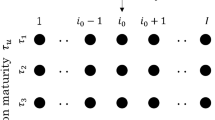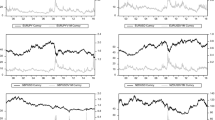Abstract
Using empirical data and the properties they reveal, we develop a factor that captures changes of both currency implied correlation and volatilities. For this purpose, we apply the Guldin–Pappus theorem in Euclidean space for rotating triangles to construct a specific factor, which we define as gravity radius. This approach allows the construction of a portfolio index aggregating all currency pairwise trades. Our factor, which is a weighted sum of all gravity radius factors in a portfolio, exhibits characteristics that are similar to the well-known turbulence metric defined in the literature and has moderate correlation to the CBOE VIX index. This factor therefore can serve as a risk indicator. We argue that the changes in volatilities impact the gravity radius factor value considerably more than changes in correlations. Portfolio managers and risk managers can use the new metric to identify correlation and volatility changes that dynamically react to new information.











Similar content being viewed by others
Notes
We use the terms “numeriare” and “base currency” interchangeably throughout this paper.
Because we deal with Euclidean space, the second axiom is not shown explicitly. In Riemannian space with negative or positive curvature, the second axiom does not hold.
Authors’ adaptation from Bulmer-Thomas (1984).
Note that the perimeter of a triangle is the sum of the lengths of all edges.
We are aware that other, simpler solutions of the problem might exist.
Mathematically, rising correlations are associated with decreasing of the angle between \({\sigma }_{{fx}_{i}}^{2}\) and \({\sigma }_{{fx}_{j}}^{2}\); cos(90°) = 0, and cos (0°) = 1. Vidyamurthy (2004) calculated the angle between two vectors and provides a geometric interpretation of the distance measure.
Bloomberg Ticker CVIX1I Index.
We thank the anonymous reviewers for pointing this out.
Konstantinov et al. (2020) showed that currencies exhibit large centrality scores in a directed asset network.
See Gamov (1961) for a more detailed explanation of this issue.
References
Asness, C., Frazzini, A., Gormsen, N. J., & Pedersen, L. H. (2020). Betting against correlation: Testing theories of the low-risk effect. Journal of Financial Economics, 135(3), 629–652.
Black, F., Derman, E., & Toy, W. (1990). A one factor model of interest rates and its application to Treasury bond options. Financial Analysts Journal, 46(1), 33–39.
Bollerslev, T. (1986). Generalized autoregressive conditional heteroscedasticity. Journal of Econometrics, 31, 307–327.
Bulmer-Thomas, I. (1984). “Guldin’s theorem—Or Papus’s? Isis, 75(2), 348–352.
Chen, S.-H. (2017). Carry trade strategies based on option-implied information: Evidence from a cross-section of funding currencies. Journal of International Money and Finance, 78, 1–20.
Cox, J. C., Ross, S. A., & Rubinstein, M. (1979). Option pricing: A simplified approach. Journal of Financial Economics, 7(2), 229–263.
Do, B., & Faff, R. (2010). Does simple pairs trading still work? Financial Analysts Journal, 66(4), 1–13.
Elliot, R. J., Van Der Hoek, J., & Malcolm, W. P. (2005). Pairs trading. Quantitative Finance, 5(3), 271–276.
Engelberg, J., Gao, P., & Jagannathan, R. (2009). An anatomy of pairs trading: The role of idiosyncratic news, common information and liquidity. In Third Singapore international conference in Finance.
Engle, R. F. (1982). Autoregressive conditional heteroscedasticity with estimates of the variance of U. K. inflation. Econometrica, 50, 987–1008.
Focardi, S. M., & Fabozzi, F. J. (2012). What’s wrong with today’s economics? The current crisis calls for an approach to economics rooted more on data than on rationality. Journal of Portfolio Management, 38(3), 104–119.
Focardi, S. M., Fabozzi, F. J., & Mazza, D. (2020). Quantum option pricing and quantum finance. Journal of Derivatives, 28(1), 79–98.
Gamov, G. (1961). One, two, three…infinity: Facts and speculations of science. Viking Press.
Gatev, E., Goetzmann, W. N., & Rouwenhorst, K. G. (2006). Pairs trading: Performance of a relative-value arbitrage rule. Review of Financial Studies, 19(3), 797–827.
Geman, H., & Souveton, R. (1997). No arbitrage between economies and correlation risk management. Computational Economics, 10(2), 119–138.
Harris, J. W., & Stocker, H. (1998). Guldin’s rules. In Handbook of Mathematics and Computational Science. Springer.
Kern, W. F., & Bland, J. R. (1948). Theorem of Pappus. Chapter 40 in Solid Mensuration with Proofs, 2nd Edition (pp. 110–115) Wiley.
Kinlaw, W., & Turkington, D. (2014). Correlation surprises. Journal of Asset Management, 14(6), 385–399.
Konstantinov, G., Chorus, A., & Rebmann, J. (2020). A network and machine learning approach to factor, asset, and blended allocation. Journal of Portfolio Management, 46(6), 54–71.
Konstantinov, G., & Rebmann, J. (2019). From risk factors to networks: A case study on interconnectedness using currency funds. Journal of Financial Data Science, 1(3), 108–123.
Kritzman, M., & Li, Y. (2010). Skulls, financial turbulence, and risk management. Financial Analysts Journal, 66(5), 30–41.
Kritzman, M., Li, Y., Page, S., & Rigobon, R. (2011). Principal components as a measure of systemic risk. Journal of Portfolio Management, 37(4), 112–126.
Kritzman, M., Page, S., & Turkington, D. (2012). Regime shifts: Implications for dynamic strategies. Financial Analysts Journal, 68(3), 22–39.
Margrabe, W. (1993). Triangular equilibrium and arbitrage in the market for options to exchange two assets. Journal of Derivatives, 1(1), 60–69.
Meissner, G. (2016). Correlation trading strategies: Opportunities and limitations. Journal of Trading, 11(4), 14–32.
Menkhoff, L., Sarno, L., Schmeling, M., & Schrimpf, A. (2012). Carry trades and global foreign exchange volatility. Journal of Finance, 67(2), 681–718.
Moran, M. T. (2014). Thirty Volatility Indexes: Worldwide tools to gauge sentiment and diversify portfolios. Journal of Index Investing, 4(4), 69–87.
Neely, C. J., & Weller, P. A. (2013). Lessons from the evolution of foreign exchange trading strategies. Journal of Banking & Finance, 37(10), 3783–3798.
Phoa, W. (2013). Portfolio concentration and the geometry of co-movement. Journal of Portfolio Management, 39(4), 142–151.
Pojarliev, M., & Levich, R. (2008). Do professional currency managers beat the benchmark? Financial Analysts Journal, 64(5), 18–32.
Raffinot, T. (2018). Hierarchical clustering-based asset allocation. Journal of Portfolio Management, 44(2), 89–99.
Stoyanov, S. V., Rachev, S. T., Racheva-Yotova, B., & Fabozzi, F. J. (2011). Fat-tailed models for risk estimation. Journal of Portfolio Management, 37(2), 107–117.
Taleb, N. N. (1997). Dynamic Hedging: Managing Vanilla and Exotic Options. Wiley.
Vidyamurthy, G. (2004). Pairs Trading: Quantitative Methods and Analysis. Wiley.
Whaley, R. E. (2009). Understanding the VIX. Journal of Portfolio Management, 35(3), 98–105.
Author information
Authors and Affiliations
Corresponding author
Additional information
Publisher's Note
Springer Nature remains neutral with regard to jurisdictional claims in published maps and institutional affiliations.
Rights and permissions
About this article
Cite this article
Konstantinov, G.S., Fabozzi, F.J. The Geometry of the World of Currency Volatilities. Comput Econ 60, 125–145 (2022). https://doi.org/10.1007/s10614-021-10140-7
Accepted:
Published:
Issue Date:
DOI: https://doi.org/10.1007/s10614-021-10140-7




